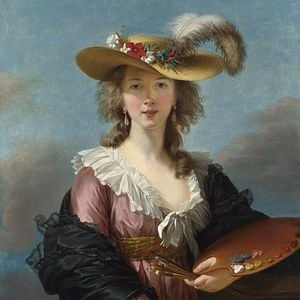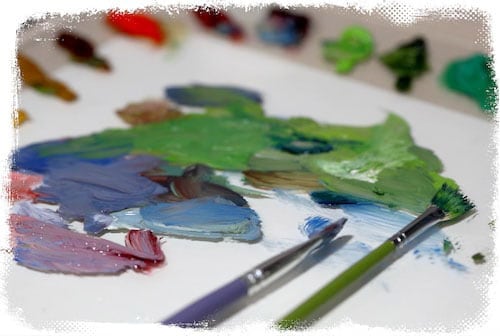
Élisabeth Vigée-Lebrun
Élisabeth Vigée-Lebrun
1 to 30 out of 247 items
1 to 30 out of 247 items
Élisabeth Louise Vigée Le Brun, also known as Madame Le Brun, was a French portrait painter, especially of women, in the late 18th and early 19th centuries.
Her artistic style is generally considered part of the aftermath of Rococo with elements of an adopted Neoclassical style. Her subject matter and color palette can be classified as Rococo, but her style is aligned with the emergence of Neoclassicism. Vigée Le Brun created a name for herself in Ancien Régime society by serving as the portrait painter to Marie Antoinette. She enjoyed the patronage of European aristocrats, actors, and writers and was elected to art academies in ten cities.
Vigée Le Brun created 660 portraits and 200 landscapes. In addition to many works in private collections, her paintings are owned by major museums, such as the Louvre Paris, Uffizi Florence, Hermitage Museum Saint Petersburg, National Gallery in London, Metropolitan Museum of Art in New York and many other collections in continental Europe and the United States.
Between 1835 and 1837, when Vigée Le Brun was in her 80s, she published her memoirs in three volumes (Souvenirs).
Vigée-Le Brun was born in 1755 to humble Parisian beginnings. She exhibited a gift for the arts from a young age, although she was rejected from formal training based on her gender. Instead, the aspiring artist worked in a history painter’s atelier, took oil painting lessons, and visited the city’s most important galleries. By the 1770s, she was taking clients. By 1783, she had claimed one of the four seats reserved for women at the Academy due to direct intervention from Queen Marie Antoinette, her most famous subject, and King Louis XVI.
Her dizzying, convention-breaking rise to fame was made possible by the rapidly changing world around her. She had a unique understanding of the new style of modern individuals. Vigée-Le Brun portrayed her sitters as natural and naturally glamorous, a talent "going to a super-intuitive stylist that will make you look perfect for Instagram."
This gift for transformation and Vigée-Le Brun’s more radical beliefs were on display during the artist’s first Salon in 1783. In a departure from the structured courtly style, her submission Marie Antoinette in a Chemise Dress (1783) shows the queen in a loose-fitting muslin frock, hair unadorned, holding a rose. A self-proclaimed royalist, Vigée-Le Brun meant to reimagine royalty with modern, individualist aspirations toward authenticity, transparency, and natural virtue. To Vigée-Le Brun—and, indeed, to Marie Antoinette—the painting respected the ideas popularized by Enlightenment philosopher Jean-Jacques Rousseau, ideas upon which the 1789 French Revolution would be built.
However, to her contemporaries at the Salon, this styling was frivolous, inelegant, and inappropriate for a queen. That was one of those collision courses that was bound to end in a terrible accident. The Queen was attracted to everything pleasant and comfortable about being a modern individual, but she wanted to hang on to the prerogatives of being queen. No one wanted to obey and pay taxes to a modern individual. Vigée-Le Brun’s portrait was removed shortly after its unveiling, though its aesthetics would remain popular with the Queen and the aristocratic community.
Critics also pilloried Vigée-Le Brun for her very presence in the 1783 Salon. For many, it was impossible to believe that a woman could—or would—display her professional achievements so publicly as in the Salon. She was scathing as it was; this review points to one of the profound contradictions of Vigée-Le Brun’s work. By professionalizing and publicizing her talent, Vigée-Le Brun was breaching the Rousseauian ideas she championed. Despite his efforts to liberate humanity, Rousseau was “very conservative” toward women. Both parents were necessary for the stable rearing of a child—but a woman’s role was purely domestic. It did not extend beyond the crucial bearing, nurturing, and nourishing of offspring.
Vigée-Le Brun reasoned that men's rights must logically include women's rights. For this, Vigée-Le Brun deserves recognition as a critical painter of 18th-century France—or maybe something more. Her move into the public domain was so radical for a woman. In a way, she was the most radical painter of the period.
Most paintings Élisabeth Vigée-Lebrun did are about Portrait, Nude, and other subjects.
Most of the artist's works that can be seen by the public today are now kept in museums like Château de Versailles, The State Hermitage Museum - St Petersburg, Musée du Louvre, and others.
Famous Élisabeth Vigée-Lebrun period artists include Joseph Mallord William Turner (British, 1775 -1851), William James Müller (British, 1812 -1845), Thomas Lawrence (British, 1769 -1830), William Etty (British, 1787 -1849), John Constable (British, 1776 -1837), Gilbert Stuart (American, 1755 -1828), George Morland (British, 1763 -1804), Caspar David Friedrich (German, 1774 -1840), Karl Pavlovich Brulloff (Russian, 1799 -1852), Thomas Cole (British, 1801 -1848), John Sell Cotman (British, 1782 -1842), John Hoppner (British, 1758 -1810), and others.
Get inspired by the most famous paintings of Élisabeth Vigée-Lebrun. Pick your favorite, and one of our talented artists will make a copy just like the original, making it a unique gift or piece of art for your home. If you can't find a specific Élisabeth Vigée-Lebrun, contact us for a price quote.






























